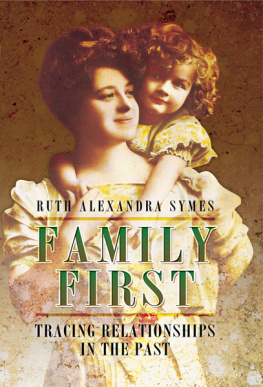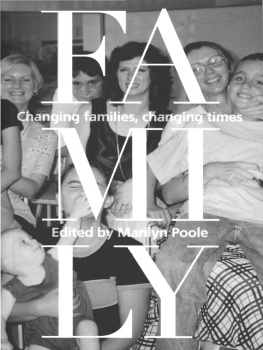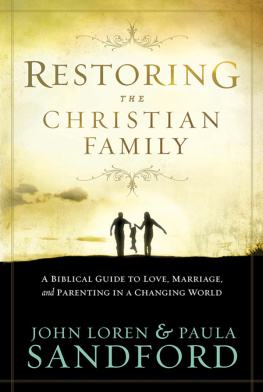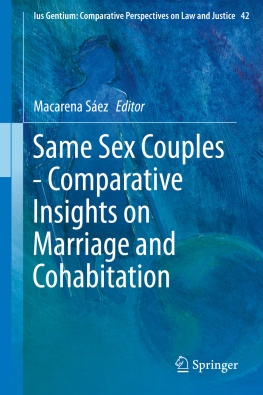The Changing American Family
The Changing American Family
Sociological and Demographic Perspectives
Edited by
Scott J. South and Stewart E. Tolnay
First published 1992 by Westview Press, Inc.
Published 2019 by Routledge
52 Vanderbilt Avenue, New York, NY 10017
2 Park Square, Milton Park, Abingdon, Oxon OX14 4RN
Routledge is an imprint of the Taylor & Francis Group, an informa business
Copyright 1992 Taylor & Francis
All rights reserved. No part of this book may be reprinted or reproduced or utilised in any form or by any electronic, mechanical, or other means, now known or hereafter invented, including photocopying and recording, or in any information storage or retrieval system, without permission in writing from the publishers.
Notice:
Product or corporate names may be trademarks or registered trademarks, and are used only for identification and explanation without intent to infringe.
Library of Congress Cataloging-in-Publication Data
The Changing American family : sociological and demographic perspectives / edited by Scott J. South and Stewart E. Tolnay.
p. cm.
Papers from a conference held in Albany, N.Y., April 6-7, 1990, sponsored by the Department of Sociology at the State University of New York at Albany.
Includes bibliographical references.
ISBN 0-8133-1100-4
1. Family demographyUnited StatesCongresses. 2. FamilyUnited StatesCongresses. I. South, Scott J. II. Tolnay, Stewart Emory. III. State University of New York at Albany. Dept. of Sociology.
HQ759.98.C45 1992
306.85'0973dc20
91-39295
CIP
ISBN 13: 978-0-367-29069-6 (hbk)
Contents
, Stewart E. Tolnay and Scott J. South
PART ONE
FAMILY PATTERNS: THE HISTORICAL DIMENSION
, Steven Ruggles and Ron Goeken
, Nancy S. Landale and Stewart E. Tolnay
, Amy E. Holmes and Maris A. Vinovskis
PART TWO
MARRIAGE AND COHABITATION: CURRENT ISSUES
, Neil G. Bennett, David E. Bloom, and Patricia H. Craig
, Robert Schoen and Dawn Owens
, Ronald R. Rindfuss and Audrey VandenHeuvel
, James A. Sweet and Larry L. Bumpass
, Scott J. South
PART THREE
FAMILIES, PARENTS, AND CHILDREN
, Frank F. Furstenberg, Jr., and Kathleen Mullan Harris
, Jay D. Teachman
, Arland Thornton
, Linda Waite and Frances K. Goldscheider
Guide
Several individuals and organizations were instrumental in making the conference for which most of these chapters were prepared a success. Still others have helped push this project toward its completion in the form of this edited volume. We wish to acknowledge here our sincere appreciation of their contributions.
Louise Tornatore, assistant to the chair of the Department of Sociology at SUNY-Albany, performed the herculean tasks of making all of the conference arrangements and seeing that things ran smoothly. They did, but only because of her tireless efforts. Joan Cipperly, administrative assistant in the Department of Sociology, also worked long and hard to ensure an effective conference. We appreciate the support of our colleagues in the sociology department, especially John Logan, chair of the department, and Richard Alba. The thoughtful comments and reactions of all of the conference participants generated a constructive exchange of ideas, and we thank them for their attendance. Dean Birkenkamp, senior editor at Westview Press, deserves our gratitude for encouraging us to publish these chapters as a collection and for tolerating the ever-changing composition of the book.
Financial support for the conference was provided by the American Sociological Association, the National Science Foundation, and SUNY-Albany's Office for Research, College of Social and Behavioral Sciences, Center for Social and Demographic Analysis, and Department of Sociology. Of course, these organizations bear no responsibility for views expressed herein. Finally, we are grateful to the editors and publishers of the American Sociological Review and Population and Development Review for permission to reprint , respectively.
Scott J. South
Stewart E. Tolnay
1
Current Themes in the Social Demography of the American Family
Stewart E. Tolnay and Scott J. South
The chapters contained in this volume are drawn from a conference held in Albany, New York, on April 6 and 7, 1990, under the title, Demographic Perspectives on the American Family: Patterns and Prospects. The tenth in a series of conferences sponsored by the Department of Sociology at the State University of New York at Albany, the Albany Conference brought together some of the most prominent sociologists, demographers, and social-historians currently studying the complex issues surrounding the changing American family. The papers presented at the conference were uniformly excellent, often provoking thoughtful debates and unusually productive exchanges of ideas and data. A unique feature of the conference was the blending of historical and contemporary perspectives on family organization and change.
Collectively, the chapters in this volume tackle a wide range of issues central to the social demography of the family. Given the myriad manifestations of change in the American family, this inclusiveness is not merely desirable but necessary. The issues receiving attention include past and current racial differences in family and household structure; the rise in and consequences of nonmarital cohabitation; the role of divorced fathers in the financial and emotional well-being of their children; changing attitudes toward marriage and family life, and the frequently conflictive division of household labor. Although these chapters have not been drafted with the explicit intention of influencing public policy (cf. Cherlin 1988), with their focus on such crucial and enduring concerns they cannot help but inform civic debate.
Our original intent in gathering together the current chapters within a single edited volume was, quite simply, to provide a forum for some of the most insightful and knowledgeable social scientists currently working in the area of family research. Of course, given space limitations it would be foolish to claim that the work represented here is exhaustive of all excellent work in the field. Nevertheless, we believe that we have been successful in achieving our primary objective. In addition, however, this collection enjoys additional benefits of our decision to spotlight the work of this particular group of scholars. As the following chapters will clearly demonstrate, the work represented here is extremely innovative in the questions posed, the data exploited, and the techniques employed. Further, there is a strong multidisciplinary flavor to the volume, with perspectives ranging from strictly demographic to the primarily social-psychological. Finally, this collection of scholarship not only provides answers to many important questions within the field of family studies but also helps to identify potentially fruitful avenues for future research. We have no doubt that much family research conducted in coming years will pursue issues that have been raised by the chapters in this book.
Second, our own interest in the subject matter of this book, as well as our choice of these specific chapters, must also be considered the result of two palpable trends in family research during the past two decades. During that period, scholarly interest and productivity in family demography and family history have grown phenomenally.











